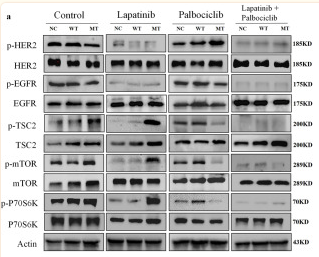Phospho-Tuberin/TSC2 (Thr1462) Antibody - #AF3334
| Product: | Phospho-Tuberin/TSC2 (Thr1462) Antibody |
| Catalog: | AF3334 |
| Description: | Rabbit polyclonal antibody to Phospho-Tuberin/TSC2 (Thr1462) |
| Application: | WB IHC IF/ICC |
| Cited expt.: | WB |
| Reactivity: | Human, Mouse, Rat |
| Prediction: | Pig, Zebrafish, Bovine, Horse, Sheep |
| Mol.Wt.: | 200 kDa; 201kD(Calculated). |
| Uniprot: | P49815 |
| RRID: | AB_2834749 |
Product Info
*The optimal dilutions should be determined by the end user. For optimal experimental results, antibody reuse is not recommended.
*Tips:
WB: For western blot detection of denatured protein samples. IHC: For immunohistochemical detection of paraffin sections (IHC-p) or frozen sections (IHC-f) of tissue samples. IF/ICC: For immunofluorescence detection of cell samples. ELISA(peptide): For ELISA detection of antigenic peptide.
Cite Format: Affinity Biosciences Cat# AF3334, RRID:AB_2834749.
Fold/Unfold
FLJ43106; LAM; OTTHUMP00000158940; OTTHUMP00000198394; OTTHUMP00000198395; PPP1R160; Protein phosphatase 1, regulatory subunit 160; tsc2; TSC2_HUMAN; TSC4; TSC4 gene, formerly; TSC4, formerly; Tuberin; Tuberous sclerosis 2; Tuberous sclerosis 2 protein; Tuberous sclerosis 2 protein homolog;
Immunogens
A synthesized peptide derived from human Tuberin/TSC2 around the phosphorylation site of Thr1462.
Liver, brain, heart, lymphocytes, fibroblasts, biliary epithelium, pancreas, skeletal muscle, kidney, lung and placenta.
- P49815 TSC2_HUMAN:
- Protein BLAST With
- NCBI/
- ExPASy/
- Uniprot
MAKPTSKDSGLKEKFKILLGLGTPRPNPRSAEGKQTEFIITAEILRELSMECGLNNRIRMIGQICEVAKTKKFEEHAVEALWKAVADLLQPERPLEARHAVLALLKAIVQGQGERLGVLRALFFKVIKDYPSNEDLHERLEVFKALTDNGRHITYLEEELADFVLQWMDVGLSSEFLLVLVNLVKFNSCYLDEYIARMVQMICLLCVRTASSVDIEVSLQVLDAVVCYNCLPAESLPLFIVTLCRTINVKELCEPCWKLMRNLLGTHLGHSAIYNMCHLMEDRAYMEDAPLLRGAVFFVGMALWGAHRLYSLRNSPTSVLPSFYQAMACPNEVVSYEIVLSITRLIKKYRKELQVVAWDILLNIIERLLQQLQTLDSPELRTIVHDLLTTVEELCDQNEFHGSQERYFELVERCADQRPESSLLNLISYRAQSIHPAKDGWIQNLQALMERFFRSESRGAVRIKVLDVLSFVLLINRQFYEEELINSVVISQLSHIPEDKDHQVRKLATQLLVDLAEGCHTHHFNSLLDIIEKVMARSLSPPPELEERDVAAYSASLEDVKTAVLGLLVILQTKLYTLPASHATRVYEMLVSHIQLHYKHSYTLPIASSIRLQAFDFLLLLRADSLHRLGLPNKDGVVRFSPYCVCDYMEPERGSEKKTSGPLSPPTGPPGPAPAGPAVRLGSVPYSLLFRVLLQCLKQESDWKVLKLVLGRLPESLRYKVLIFTSPCSVDQLCSALCSMLSGPKTLERLRGAPEGFSRTDLHLAVVPVLTALISYHNYLDKTKQREMVYCLEQGLIHRCASQCVVALSICSVEMPDIIIKALPVLVVKLTHISATASMAVPLLEFLSTLARLPHLYRNFAAEQYASVFAISLPYTNPSKFNQYIVCLAHHVIAMWFIRCRLPFRKDFVPFITKGLRSNVLLSFDDTPEKDSFRARSTSLNERPKSLRIARPPKQGLNNSPPVKEFKESSAAEAFRCRSISVSEHVVRSRIQTSLTSASLGSADENSVAQADDSLKNLHLELTETCLDMMARYVFSNFTAVPKRSPVGEFLLAGGRTKTWLVGNKLVTVTTSVGTGTRSLLGLDSGELQSGPESSSSPGVHVRQTKEAPAKLESQAGQQVSRGARDRVRSMSGGHGLRVGALDVPASQFLGSATSPGPRTAPAAKPEKASAGTRVPVQEKTNLAAYVPLLTQGWAEILVRRPTGNTSWLMSLENPLSPFSSDINNMPLQELSNALMAAERFKEHRDTALYKSLSVPAASTAKPPPLPRSNTVASFSSLYQSSCQGQLHRSVSWADSAVVMEEGSPGEVPVLVEPPGLEDVEAALGMDRRTDAYSRSSSVSSQEEKSLHAEELVGRGIPIERVVSSEGGRPSVDLSFQPSQPLSKSSSSPELQTLQDILGDPGDKADVGRLSPEVKARSQSGTLDGESAAWSASGEDSRGQPEGPLPSSSPRSPSGLRPRGYTISDSAPSRRGKRVERDALKSRATASNAEKVPGINPSFVFLQLYHSPFFGDESNKPILLPNESQSFERSVQLLDQIPSYDTHKIAVLYVGEGQSNSELAILSNEHGSYRYTEFLTGLGRLIELKDCQPDKVYLGGLDVCGEDGQFTYCWHDDIMQAVFHIATLMPTKDVDKHRCDKKRHLGNDFVSIVYNDSGEDFKLGTIKGQFNFVHVIVTPLDYECNLVSLQCRKDMEGLVDTSVAKIVSDRNLPFVARQMALHANMASQVHHSRSNPTDIYPSKWIARLRHIKRLRQRICEEAAYSNPSLPLVHPPSHSKAPAQTPAEPTPGYEVGQRKRLISSVEDFTEFV
Predictions
Score>80(red) has high confidence and is suggested to be used for WB detection. *The prediction model is mainly based on the alignment of immunogen sequences, the results are for reference only, not as the basis of quality assurance.
High(score>80) Medium(80>score>50) Low(score<50) No confidence
Research Backgrounds
In complex with TSC1, this tumor suppressor inhibits the nutrient-mediated or growth factor-stimulated phosphorylation of S6K1 and EIF4EBP1 by negatively regulating mTORC1 signaling. Acts as a GTPase-activating protein (GAP) for the small GTPase RHEB, a direct activator of the protein kinase activity of mTORC1. May also play a role in microtubule-mediated protein transport (By similarity). Also stimulates the intrinsic GTPase activity of the Ras-related proteins RAP1A and RAB5 (By similarity).
Phosphorylation at Ser-1387, Ser-1418 or Ser-1420 does not affect interaction with TSC1. Phosphorylation at Ser-939 and Thr-1462 by PKB/AKT1 is induced by growth factor stimulation. Phosphorylation by AMPK activates it and leads to negatively regulates the mTORC1 complex. Phosphorylated at Ser-1798 by RPS6KA1; phosphorylation inhibits TSC2 ability to suppress mTORC1 signaling. Phosphorylated by DAPK1.
Ubiquitinated by the DCX(FBXW5) E3 ubiquitin-protein ligase complex, leading to its subsequent degradation. Ubiquitinated by MYCBP2 independently of its phosphorylation status leading to subsequent degradation; association with TSC1 protects from ubiquitination.
Cytoplasm. Membrane>Peripheral membrane protein.
Note: At steady state found in association with membranes.
Liver, brain, heart, lymphocytes, fibroblasts, biliary epithelium, pancreas, skeletal muscle, kidney, lung and placenta.
Research Fields
· Cellular Processes > Cell growth and death > p53 signaling pathway. (View pathway)
· Cellular Processes > Transport and catabolism > Autophagy - animal. (View pathway)
· Cellular Processes > Cell growth and death > Cellular senescence. (View pathway)
· Environmental Information Processing > Signal transduction > Phospholipase D signaling pathway. (View pathway)
· Environmental Information Processing > Signal transduction > mTOR signaling pathway. (View pathway)
· Environmental Information Processing > Signal transduction > PI3K-Akt signaling pathway. (View pathway)
· Environmental Information Processing > Signal transduction > AMPK signaling pathway. (View pathway)
· Human Diseases > Infectious diseases: Viral > Human papillomavirus infection.
· Human Diseases > Cancers: Overview > Choline metabolism in cancer. (View pathway)
· Organismal Systems > Aging > Longevity regulating pathway. (View pathway)
· Organismal Systems > Endocrine system > Insulin signaling pathway. (View pathway)
· Organismal Systems > Endocrine system > Thyroid hormone signaling pathway. (View pathway)
References
Application: WB Species: Human Sample: BT474 cell
Restrictive clause
Affinity Biosciences tests all products strictly. Citations are provided as a resource for additional applications that have not been validated by Affinity Biosciences. Please choose the appropriate format for each application and consult Materials and Methods sections for additional details about the use of any product in these publications.
For Research Use Only.
Not for use in diagnostic or therapeutic procedures. Not for resale. Not for distribution without written consent. Affinity Biosciences will not be held responsible for patent infringement or other violations that may occur with the use of our products. Affinity Biosciences, Affinity Biosciences Logo and all other trademarks are the property of Affinity Biosciences LTD.




